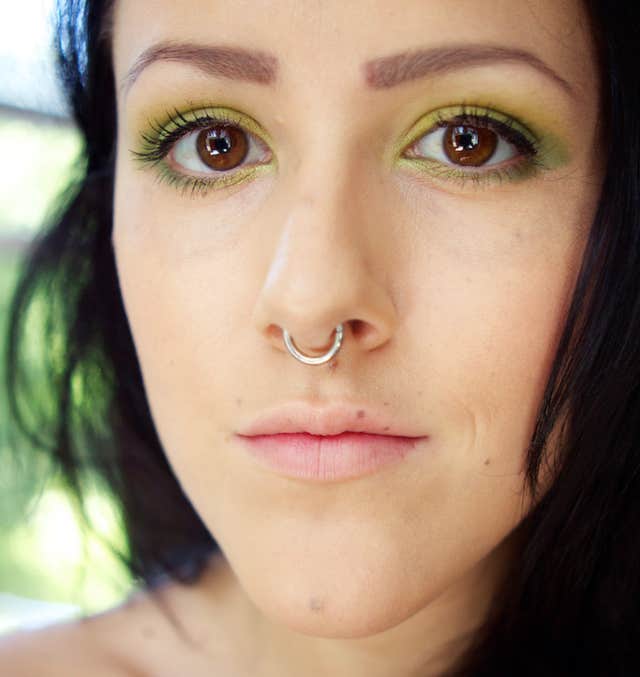What You Need To Know Before Getting Your Septum Pierced
Dress up that nose!
 freya-photographer / Shutterstock
freya-photographer / Shutterstock While many people only have their ears pierced, body piercings have been around for quite some time. It's actually a tradition that dates back 5,300 years!
But one of the most interesting is the septum piercing.
Septum piercings have existed for a long time.
They were common among Native Americans, specifically the Tecumseh, Tenskwatawa, and Shawnee tribes. The Aztecs, Mayans, and Incas, as well as individuals from Africa to Southwestern Asia, have sported the piercing.
What is a septum piercing?
A septum piercing is a piercing that passes through the thin membrane of tissue between your nostrils. It's a piercing that sits below the hard cartilage of your nose.
Septum piercings are usually closer to the tip of the nose rather than the face, as this location tends to be universally flattering.
 Photo: Grace Hagen via Wikimedia Commons
Photo: Grace Hagen via Wikimedia Commons
How much does a septum piercing cost?
Depending on the piercer you choose, the piercing studio, the jewelry, and the aftercare products you purchase, this can affect the total amount you'll spend.
The average cost for the piercing will run you anywhere between $40 to $100, which includes the jewelry but does not include the tip for your professional piercer.
How long does a septum piercing take to heal?
While the piercing may appear "hardcore" or intense (as many people commonly associate the piercing with "savagery," and/or bones through the nose), this piercing is relatively easy to sit through.
However, in terms of healing, septum piercings take at least four or five months to heal fully! The piercing should start to feel better in six-to-eight weeks. This is a bit longer than the standard nose piercing.
The upside is that during the healing process, you can flip up your septum ring whenever you want. However, make sure you do this with clean hands, since you don't want the piercing to get infected.
As for a weird smell, don't panic. This is simply due to a build-up of oils and dead skin cells that get stuck around the jewelry. It's best to clean often. But instead of wondering when you can change your septum piercing, it's best to wait the recommended amount of weeks.
How are septum piercings performed?
The piercing process of the septum is quite simple.
Your piercer will start by marking where the needle will thread through the thin cartilage between the right and left nostrils; they call this the "sweet spot."
Then, your piercer will do one of three things: freehand the needle, use septum forceps, or use a receiving tube to hold the cartilage in place. Lastly, the needle will pierce through the cartilage using a taper, and the piece of jewelry will be threaded through.
There are three types of metals to choose from for a septum piercing.
There's stainless steel, which is one of the safest metals to have because it's hypoallergenic; there's titanium, which can be a bit pricier but is super-durable; and there's niobium, which is used for people with sensitive skin and tends to have a low reaction rate.
How much does it hurt?
Unlike getting your ears pierced, where the needle or piercing gun goes through the lobe, a septum piercing is on a thin layer of cartilage. This means you may feel more pain; however, everyone has a different pain threshold they can withstand.
Many people who have gotten septum piercings do report that they tear up during the procedure. But this is just a natural nervous system response, so don't be too hard on yourself for your reaction.
What are the risks of septum piercings?
Like any other piercing, there will be risks when getting a septum pierced. You could have an allergic reaction to the metal used, or the open wound could get infected.
A septal hematoma, which is a collection of blood within the septum, is a complication that can develop if the piercing damages the blood vessels within the nasal tissue causing pain, swelling, pressure and congestion.
Other risks include scarring, tearing, and bloodborne diseases that can occur. All of these risks are exactly why you should go to experienced piercers.
How do you clean a septum piercing?
If you've never gotten a piercing anywhere before, aftercare is an essential step in making sure your piercing doesn't become infected or heal improperly.
For the first few weeks after your piercing, do sea salt solution soaks and choose specific antiseptics. For the sea salt soak, saturate a cotton ball in aftercare spray and press it against the piercing. Repeat this process for five minutes.
Another method includes using good quality sea salt, not to be confused with table salt. Combine this with boiled water to sterilize it, and add one cup of water to every 1/4 teaspoon of sea salt. Use cotton balls to apply the solution once it's fully mixed.
For people who experience any issues with their piercing, consider using antiseptic spray or swabs.
When your piercing is healing, also be sure that you don't traumatize the piercing (like when you have to blow your nose), use blood thinners (including alcohol and caffeine), swim in a pool, use soap directly on the piercing, apply lotions or creams, or remove the piercing prematurely.
Can you stretch a septum piercing?
The short answer is that it's not recommended to stretch a septum piercing. However, it can be done.
You have to stretch it under strict rules or you can risk damaging your piercing. You will need to wait six-to-eight months between each stretch and only stretch about 0.5mm each time.
It's slow and steady wins the race when stretching a septum piercing.
How long do you have to wait to change the jewelry?
You should always wait until the piercing is fully healed to change the jewelry!
However, you're able to start changing jewelry at around the six-to-eight-week mark. Then, you can insert your horseshoe-shaped, circular barbell, and captive bead rings.
Just be sure to keep everything clean to avoid an infection. You can use saline solution for this.
How do you hide a septum piercing?
Just like hiding tattoos, while more obvious piercings — ears, nose ring, labret, and even tongue — are difficult or impossible to hide, a septum piercing is surprisingly easy, both during and after healing.
All you need to do is turn the jewelry upside down, but it does depend on how healed the piercing is. For newly healed septum piercings, use a thin ring (the recommended size is 16 gauge).
Use a piece of tape that's skin-colored to cover the area temporarily, particularly if you want to hide it for work or if you're being physically active. Be sure to remove the tape each day, and replace it with fresh new tape. Of course, you'll want to clean the piercing each day as well.
After waiting six-to-eight weeks for the piercing to heal, another method is to use a septum retainer. A septum retainer is a piece of jewelry specifically designed to hide the septum ring. You can use the retainer to flip it inside your nose, making your piercing much less obvious.
Just like if you were changing your septum ring, the process is similar with a retainer. Remove the stoppers (the balls on the end of the ring) and put it up to your nose, slowly pushing the retainer through the holes. Then, reattach the stoppers.
Nicole Lane is a wife, mother, writer, and regular contributor for YourTango. She is a staunch defender of women's rights, she believes firmly in equality and parity, and she is an advocate for women's health, mental health, and sexuality.

